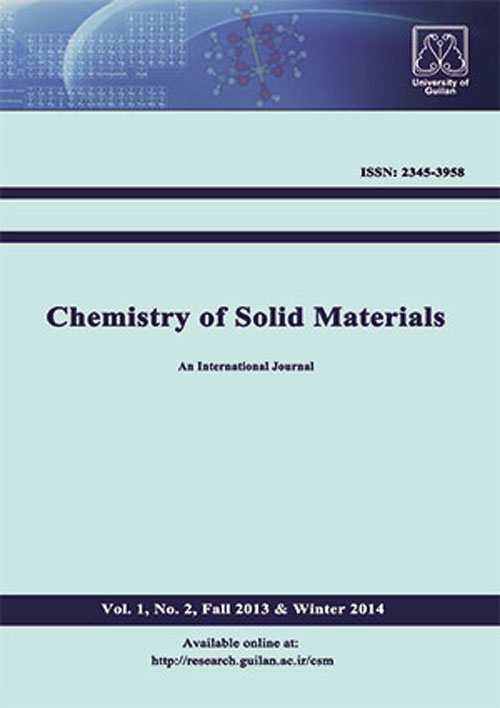فهرست مطالب
Chemistry of Solid Materials
Volume:1 Issue: 1, Winter 2013
- تاریخ انتشار: 1394/11/25
- تعداد عناوین: 6
-
Page 1A series of CuO-ZnO-Al2O3 nanoparticles over HZSM-5 were successfully prepared using different methods of batch co-precipitation, semibatch co-precipitation and combined co precipitation-ultrasound. Nitrates of copper, zinc and aluminum were used as precursors, while Na-ZSM-5 was employed as composite support and sodium carbonate was used as precipitant agent. The effects of preparation methods on physicochemical properties of synthesized nanoparticles were studied using XRD, BET, FESEM, FTIR and TGA-DTG techniques. Furthermore, the formation mechanism of nanosized CuO-ZnO-Al2O3 over HZSM-5 was proposed. The formation of nanosized CuO-ZnO-Al2O3 over HZSM-5 with homogeneous grain size was addressed after calcination at 350°C for 5 hr. The results indicated that the crystalline structure, thermal gravimetric behavior and surface morphology of the nanocomposite were strongly dependent on preparation methods. The combined co-precipitation ultrasound method had superior control in crystallite size and CuO-ZnO-Al2O3 dispersion. This method resulted in many small grains with almost spherical shapes and narrow particle size distribution.Keywords: ZnO, CuO, Al2O3, HZSM, 5, Nanoparticle, Co, precipitation, Ultrasound
-
Page 17Oxidation reaction of indole to isatin was performed in the presence of Fe3O4 nanoparticles (as catalyst) and commercial grade perhydrol (as oxidant). Magnetite nanoparticles were synthesized via chemical precipitation method and characterized by XRD and TEM techniques. The efficiency of reaction was obtained from GC analysis of the mixture. The catalyst was easily separated from the reaction mixture (after completion or before each injection) by using a magnetic field of 1.4 T. The recycled catalyst maintained activity for successive runs.Keywords: Isatin, Fe3O4, Nanoparticle, Oxidation, Catalyst
-
Page 23In this work application of seven synthetic polymers as adsorbents for the removal of Hg(II) from aqueous solution was studied. The equilibrium studies are systematically carried out in a batch process, covering various process parameters that include agitation time, adsorbent dosage, and pH of the aqueous solution. Variations of Hg(II) concentration in solution have been studied through measuring the amount of DTZ-Hg(II) complex by a double-beam spectrophotometer. Because of absorbance interference of DTZ-Hg(II) complex with DTZ ligands at 480 nm, which is λmax of the complex, the absorbance peak was checked at 595 nm, which belongs to DTZ ligands. Decreasing of Hg(II) concentration after contacting with the adsorbents expressed the efficiency of these absorbents in extraction of mercury(II) even in solution with high mercury(II) concentrations. It was observed in adsorption and desorption tests that synthetic polymers showed significant pH dependence, which affected the removal efficiency, robustly. Adsorption behavior is found to follow Freundlich and Longmuir isotherms. A regeneration study was also carried out.Keywords: Mercury, Synthetic polymers, Adsorption, Pollution, Wastewater treatment
-
Page 33Copper (II) phthalocyanine and 2, 9, 16, 23 tetrakis nitro copper (II) phthalocyanine has been synthesized respectively from phthalonitrile and 4-nitro phthalonitrile under solvent-free condition using two different catalysts over nanodimensional zeolites. 4-Nitro phthalonitrile synthesized from phthaimide in three steps. The newly prepared compounds have been characterized by IR, UV-Vis,1H NMR and MS spectra.Keywords: Phthalocyanine, Nanodimensional zeolite, solvent, free, phthalonitrile
-
Page 41TiO2 nanorods are synthesized by a thermal corrosion. In present work, synthesis of TiO2 nanorods in anatase, rutile and Ti8O15 phases, by using the sol-gel method and alkaline corrosion are reported. The morphologies and crystal structures of TiO2 nanorods are characterized by use of field emission scanning electron microscopy, atomic force microscopy and X-ray diffractometer techniques. The obtained results illustrate an aggregated structure at high calcined temperatures with the production of spherical particles. The effects of chemical compositions and calcined temperatures on surface topography and crystallization of phases are studied. Moreover, activation energy of nanoparticles formation is calculated during thermal treatment.Keywords: Nanostructur, TiO2 Nanorods, Sol, gel method
-
Page 53The Taguchi method was applied as an experimental design to determine optimum conditions for colour removal from azo dyes solutions containing remazol yellow G by electrocoagulation (EC) using iron and steel electrodes as anode and cathode, respectively. An orthogonal array (OA9) experimental design that allows to investigation the simultaneous variations of four parameters (initial remazol yellow G concentration, initial pH of the solution, time of electrolysis and current density) which have three levels was employed to evaluate the effects of experimental parameters. Performance measure analysis was followed by performing a variance analysis, in order to determine the optimum levels and relative magnitude of the effect of parameters. The desired characteristic for response has been elected as maximum decolourization. Therefore, Taguchis the larger the better performance formula was used. The optimum conditions were found to be initial remazol yellow G concentration, 100 mg/l, initial pH of the solution 9, time of electrolysis, 25 min, and current density, mAcm-2.Keywords: Electrocoagulation, Decolorization, Remazol yellow G, Taguchi method


